When your product is complex, your web app design shouldn't be. For B2B SaaS companies, the line between winning a new customer and losing them is often drawn at the first scroll. If the interface feels clunky or the flow doesn't make sense, users bounce, and they rarely come back.
A well-structured web app design isn’t just about how it looks. It’s about clarity, speed, and guiding users toward action. In 2025, with more SaaS buyers expecting near-instant answers and seamless digital experiences, companies can't afford to treat design as an afterthought.
If you're building or refining your web presence, this guide will show you what strong web app design really means for SaaS and how to avoid the common traps.
Key takeaways
- User-Centered Design: Focus on clarity, speed, and intuitive navigation to ensure users can complete tasks efficiently.
- Core Principles: Ensure consistency across screens, responsiveness on all devices, and optimized performance for faster load times.
- Trends in 2025: Incorporate AI-assisted interfaces, minimalist design, accessibility-first approaches, and dark mode as a standard feature.
- Scalable Web App Design: Utilize modular design systems and prioritize real user workflows to build apps that can grow with your business.
- Avoid Common Pitfalls: Don’t overload interfaces, neglect mobile responsiveness, or skip user feedback during design to ensure long-term success.
What Web App Design Means and How It Differs from a Typical Website
Web app design is the process of creating user interfaces that enable users to interact directly with your software through a browser. It involves both visual design (how things look) and functional design (how things work). For B2B SaaS companies, this usually includes dashboards, portals, account settings, billing views, and tools your customers rely on daily.
So how is it different from a regular website?
Unlike traditional websites that present information and try to generate interest, a web app needs to help users do something, manage data, customize settings, generate reports, or trigger actions.
And if that experience feels clunky or inconsistent? Users won’t just bounce, they'll lose trust in the product itself. For B2B SaaS, a solid web app design isn’t a bonus. It’s what keeps users engaged, reduces churn, and proves the value of your software in daily use.
With a clear understanding of what web app design entails, the next step is to explore the core principles that make such designs effective and user-friendly.
Key Principles of Effective Web App Design for B2B SaaS
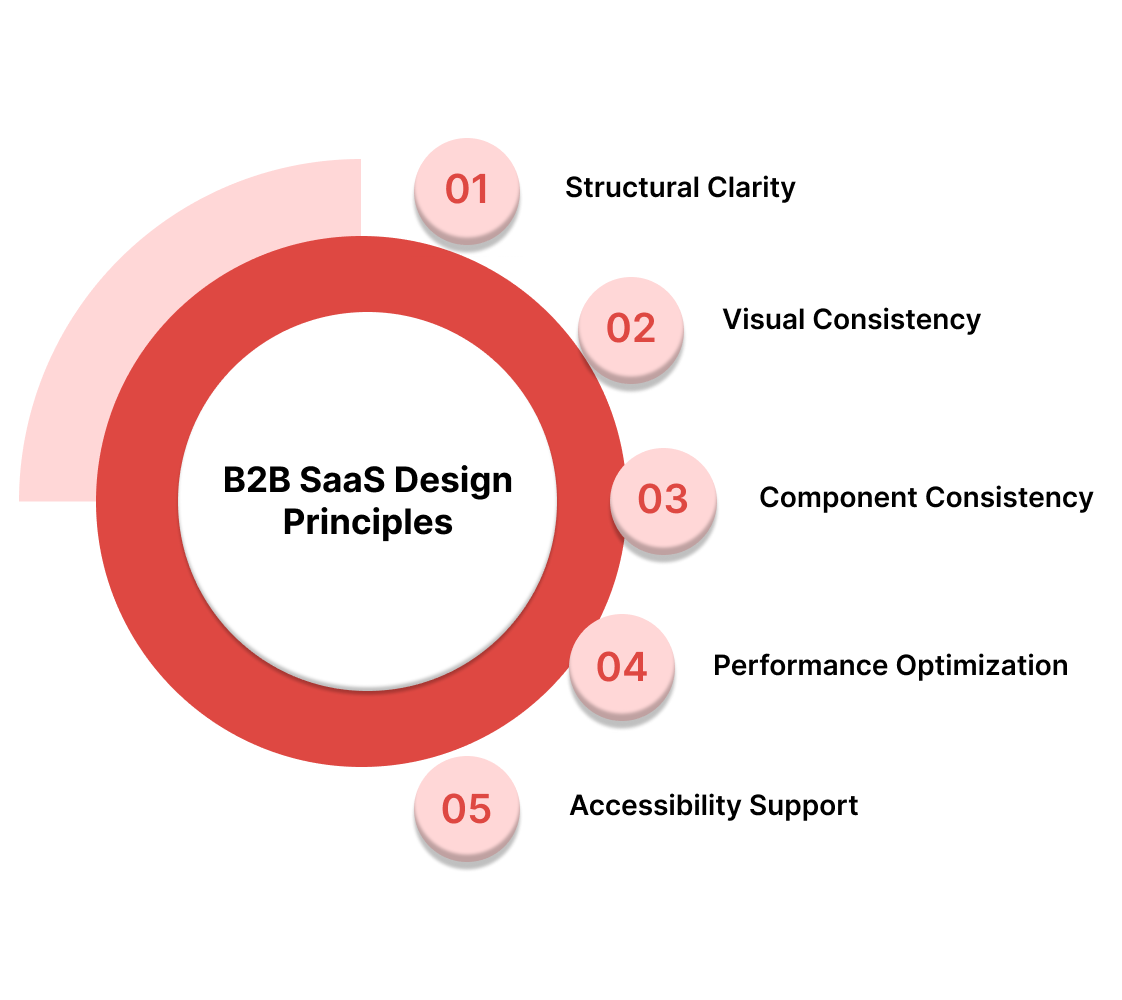
A well-designed web app supports the user’s goals without introducing unnecessary steps or confusion. For B2B SaaS companies, where users interact with complex data and make decisions that impact operations or revenue, design must be deliberate, structured, and performance-focused. The following principles form the foundation of effective web app design in a SaaS environment:
1. Clarity in Structure and Function
The interface should guide users with minimal effort. Clear labeling, intuitive navigation, and logical grouping of actions are essential.
- Use straightforward language across all UI elements
- Present key actions and workflows upfront
- Avoid clutter by prioritizing the most relevant information
2. Consistency Across Screens and Components
Consistency reduces the user’s cognitive load and enables faster task completion.
- Apply a unified design system throughout the app
- Ensure familiar interactions across similar modules
- Use consistent feedback (e.g., alerts, confirmations) for similar actions
3. Responsive and Adaptive Layouts
A large portion of SaaS users access applications on multiple screen sizes. Responsive design ensures the interface remains usable and visually balanced at all times.
- Adapt layouts fluidly to desktop, tablet, and mobile
- Maintain functionality without compromising usability
- Avoid horizontal scrolling and overlapping components
4. Optimized Performance
Speed plays a critical role in user satisfaction and retention. Delays in loading or interaction lead to user frustration and decreased productivity.
- Optimize frontend performance by reducing script weight and load time
- Implement loading states that clearly communicate system activity
- Minimize the number of actions required to complete core workflows
5. Built-In Accessibility
Accessible design expands the reach of your product and ensures compliance with international standards.
- Adhere to WCAG 2.1 guidelines
- Ensure keyboard operability and readable contrast
- Use semantic HTML for better screen reader compatibility
These principles not only contribute to a more intuitive user experience but also support product adoption, customer retention, and long-term scalability.
Having laid out these foundational principles, it’s important to understand which design trends are shaping web app development in 2025.
Web App Design Trends to Watch in 2025
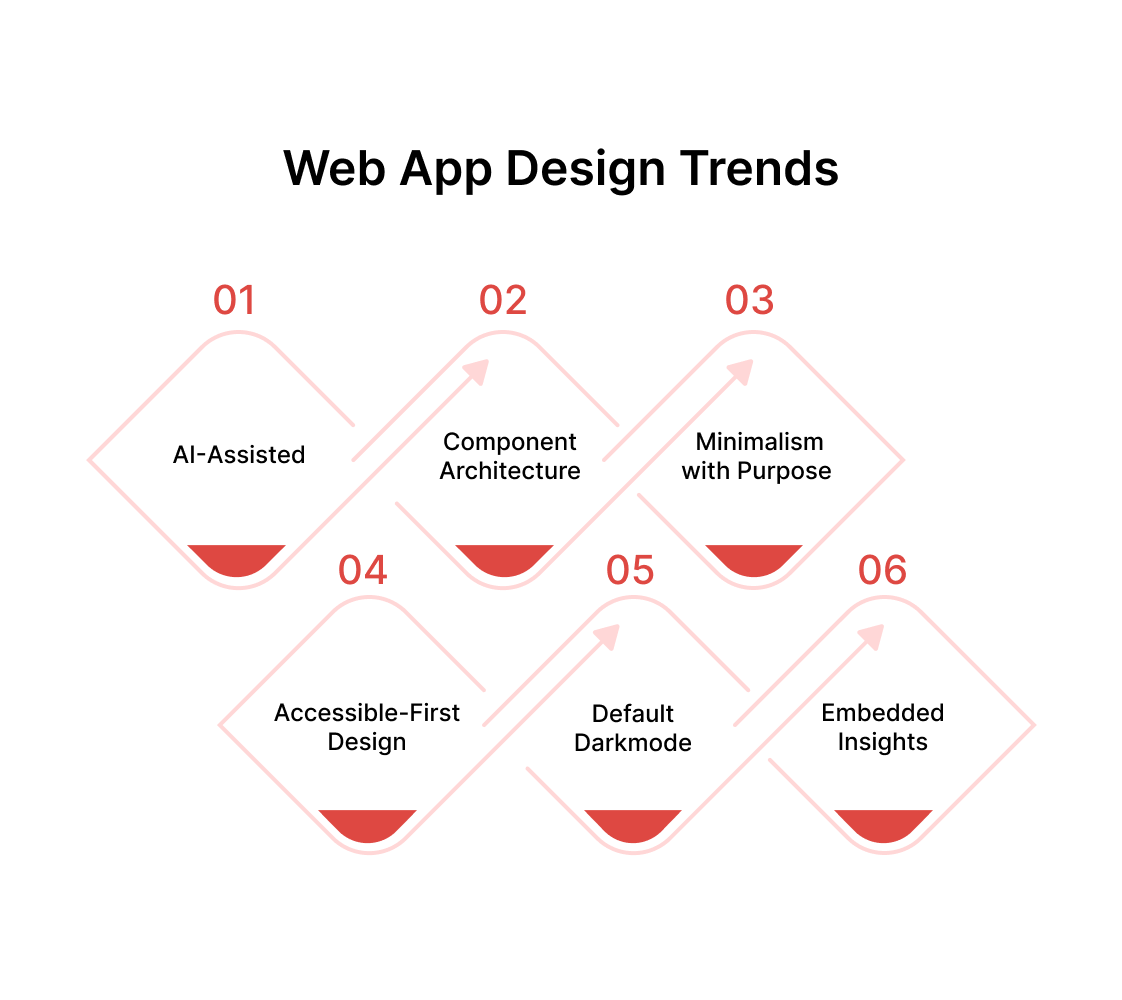
Design isn’t static. As user behavior shifts and technology evolves, so do expectations. For B2B SaaS companies, these trends aren't about chasing aesthetics; they reflect how buyers use software to make fast, informed decisions. The following trends are shaping how web apps are being built and refined in 2025:
1. AI-Assisted Interfaces
Web apps are increasingly using AI to simplify the interface. Predictive inputs, smart defaults, and behavior-based suggestions help users move faster without relying on traditional menus or step-by-step guidance.
- Example: Auto-filling fields based on past usage or account context
- Benefit: Reduces manual input and shortens decision time
2. Component-Based Design Systems
Scalable design starts with repeatable parts. Modular systems built with tools like Figma and integrated into frontend frameworks (like React) allow teams to update UI consistently without affecting performance.
- Example: Reusable UI libraries for buttons, cards, and modals
- Benefit: Faster rollouts and consistent updates across the product
3. Minimalism with Purpose
The trend toward clean, distraction-free interfaces continues but it’s no longer just visual. Designers are actively removing features that don’t contribute to the user’s core goals.
- Example: Focused dashboards with just the essentials above the fold
- Benefit: Less cognitive load, quicker navigation, better outcomes
4. Accessible-First Design
With accessibility lawsuits on the rise and compliance requirements tightening, accessibility is being built in from day one, not tacked on later. This includes color-safe palettes, logical tab flows, and dynamic font scaling.
- Example: WCAG-compliant templates and pattern libraries
- Benefit: Broader user reach and legal compliance with no loss in usability
5. Dark Mode as Standard, Not a Feature
Dark mode is now expected, especially for apps used throughout the workday. Users want control over how they consume interfaces in different lighting conditions.
- Example: System-aware theme switching tied to OS settings
- Benefit: Reduces eye strain and gives users a sense of personalization
6. Embedded Analytics and Micro-Reporting
Users want to see value instantly. Web apps are increasingly integrating contextual data into dashboards, modals, and sidebars without requiring users to open separate analytics modules.
- Example: Inline charts showing activity trends or usage stats
- Benefit: Enables data-driven action without leaving the workflow
With these trends in mind, the focus turns to the best practices that ensure your web app design remains scalable and adaptable as your business grows.
Best Practices for Designing Scalable Web Apps
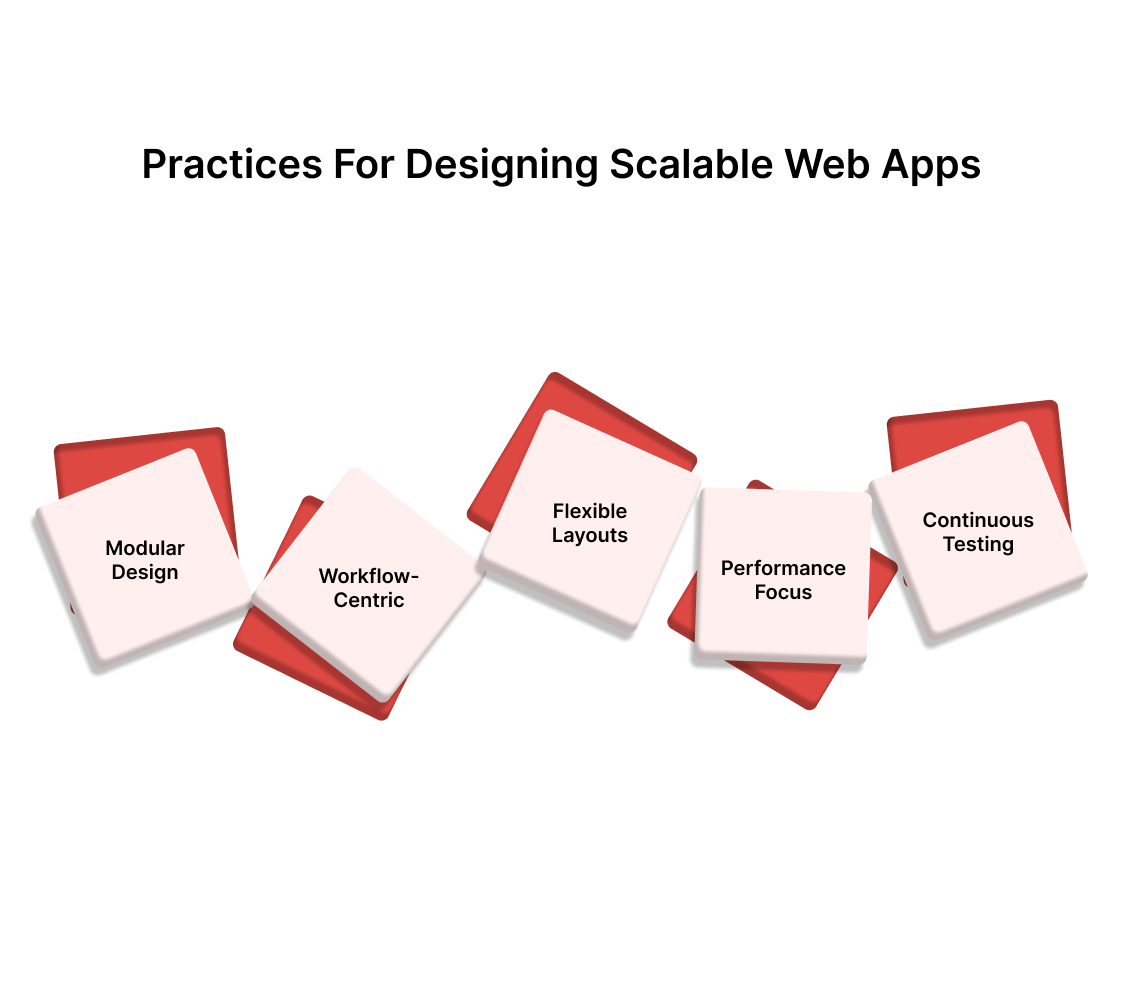
As your B2B SaaS product grows, so does the complexity behind it. What feels smooth at launch can start to break down at scale unless your design decisions anticipate growth. Scalable web app design is about more than supporting higher traffic. It’s about building interfaces that stay fast, clear, and user-friendly, even as features expand and workflows evolve.
Here’s how to get it right from the start:
1. Build with a Modular Design System
Scalability starts with consistency. A modular system lets your team reuse components instead of reinventing them.
- Break down UI into building blocks buttons, forms, tables, modals
- Use frameworks like React or Vue for repeatable, adaptable components
- Document design rules to avoid drift across teams
Think of it like Lego, you want to build complex interfaces by snapping together proven pieces, not sculpting from scratch each time.
2. Design for Real Workflows, Not Just Features
Your users don’t log in to admire features; they come to complete tasks.
- Map actual user journeys before designing screens
- Prioritize high-frequency flows like billing, approvals, and exports
- Cut or consolidate low-use steps to reduce cognitive load
If your app reflects how users naturally work, it’ll feel intuitive even as it grows.
3. Make Layouts Flexible from Day One
Future features, localizations, and extra data fields are inevitable. Locking down your layout now only causes pain later.
- Use fluid grids and container-based layouts
- Avoid hardcoded placements that break when content changes
- Leave space (visually and structurally) for future modules
Good layout planning is like good city planning it should allow for expansion without tearing everything down.
4. Design with Performance in Mind
Scalability without speed is pointless. A slow interface creates friction, especially when users handle large data sets.
- Implement lazy loading and data pagination for heavy views
- Compress assets and minimize script bloat
- Continuously audit performance using tools like Lighthouse
Fast apps aren’t just nicer to use, they convert and retain better.
5. Treat Testing as Ongoing, Not One-and-Done
A design that works at 100 users might fail at 10,000. Catch weak spots before they become bottlenecks.
- Run usability tests with varied user types
- Track real usage to find friction points early
- Automate design regression tests as your app evolves
Scaling gracefully means listening to the data and adapting before users complain.
Essential Tools and Technologies for Web App Design
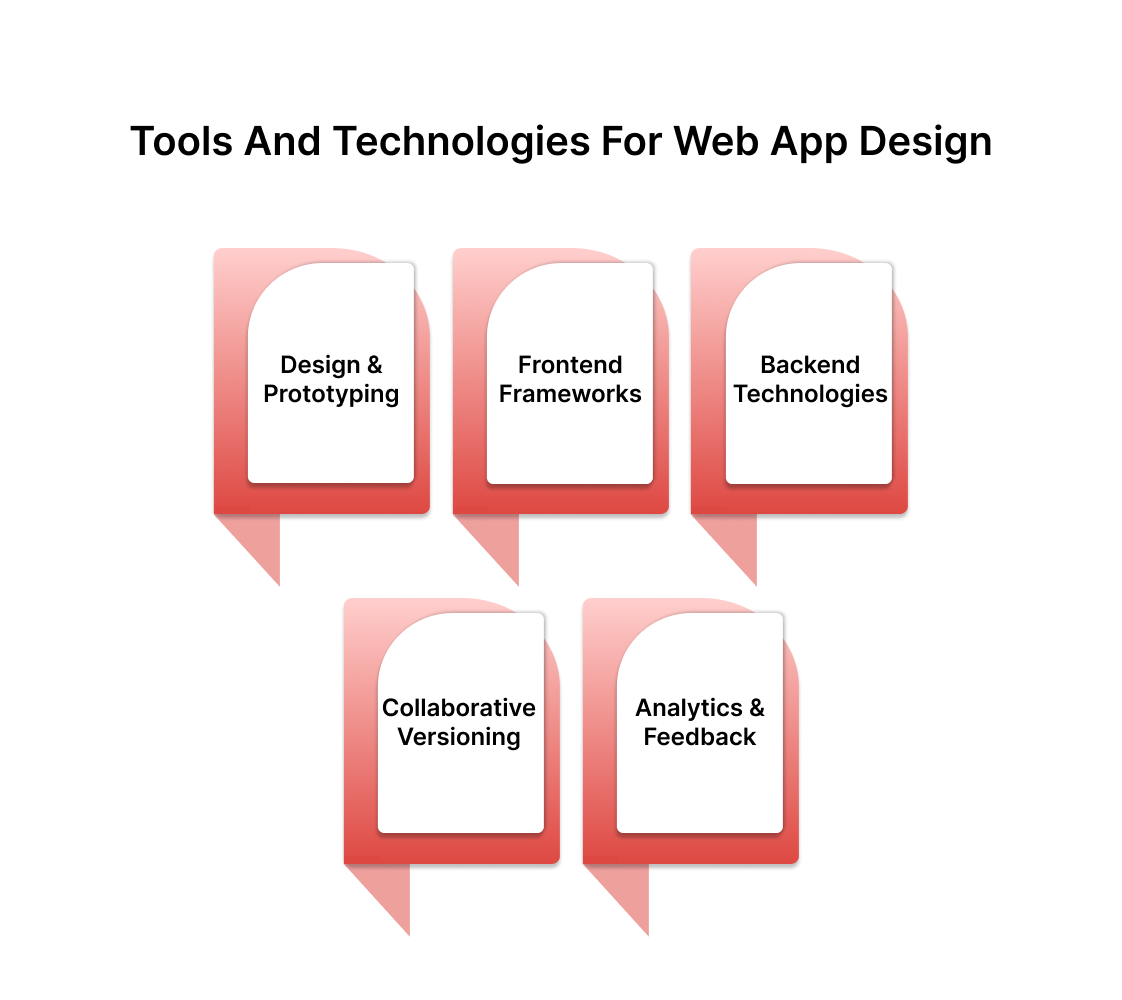
A scalable, user-friendly web app doesn’t come together with visuals alone. It relies on a reliable stack of tools that support collaboration between design and engineering, ensure responsive performance, and make iterations easier as your product matures. For B2B SaaS, selecting the right tools early helps avoid costly rewrites and fragmented systems later.
1. Design and Prototyping Tools
Strong design foundations start here where UX, UI, and team collaboration align.
- Figma: Cloud-based, real-time collaboration, ideal for teams working across time zones.
- Adobe XD: Useful for prototyping and wireframing, especially if teams are already in the Adobe ecosystem.
- Zeroheight: Helps document and share design systems with development teams.
These tools reduce handoff errors and allow faster iteration before development begins.
2. Frontend Frameworks
These frameworks make UI development structured and repeatable.
- React.js: A go-to for building reusable components in scalable SaaS apps.
- Vue.js: Lightweight and beginner-friendly, with growing enterprise adoption.
- Tailwind CSS: A utility-first CSS framework that encourages consistency and keeps your design system tight.
They support modular builds that grow cleanly as new features are added.
3. Backend Technologies
The backbone of your web app’s data logic, security, and performance.
- Node.js: Non-blocking, event-driven architecture that handles real-time data well.
- Django (Python): Secure, robust, and well-suited for apps that require fast API development.
- Ruby on Rails: Good for rapid development of MVPs and smaller apps with strong community support.
Choosing the right backend depends on your use case and performance needs.
4. Version Control and Collaboration
Effective scaling means tracking every change and avoiding collisions between teams.
- Git + GitHub/GitLab: Critical for versioning, team workflows, and maintaining code history.
- Storybook: Live style guide for UI components, making cross-functional reviews more efficient.
These tools support clean, coordinated builds, especially when multiple teams are contributing at once.
5. Analytics and Feedback
Design doesn’t stop at launch. Understanding how users interact with your app is key to refining it.
- Hotjar / FullStory: Session recordings and heatmaps for identifying drop-offs or confusion.
- Google Analytics 4: Tracks usage behavior and engagement metrics.
- Mixpanel: Powerful for product analytics and measuring user flows or feature adoption.
They help design teams make informed updates, grounded in real usage—not assumptions.
With the right tools in place, it’s useful to look at common mistakes that you should avoid for strong web app design.
Common Mistakes to Avoid in Web App Design
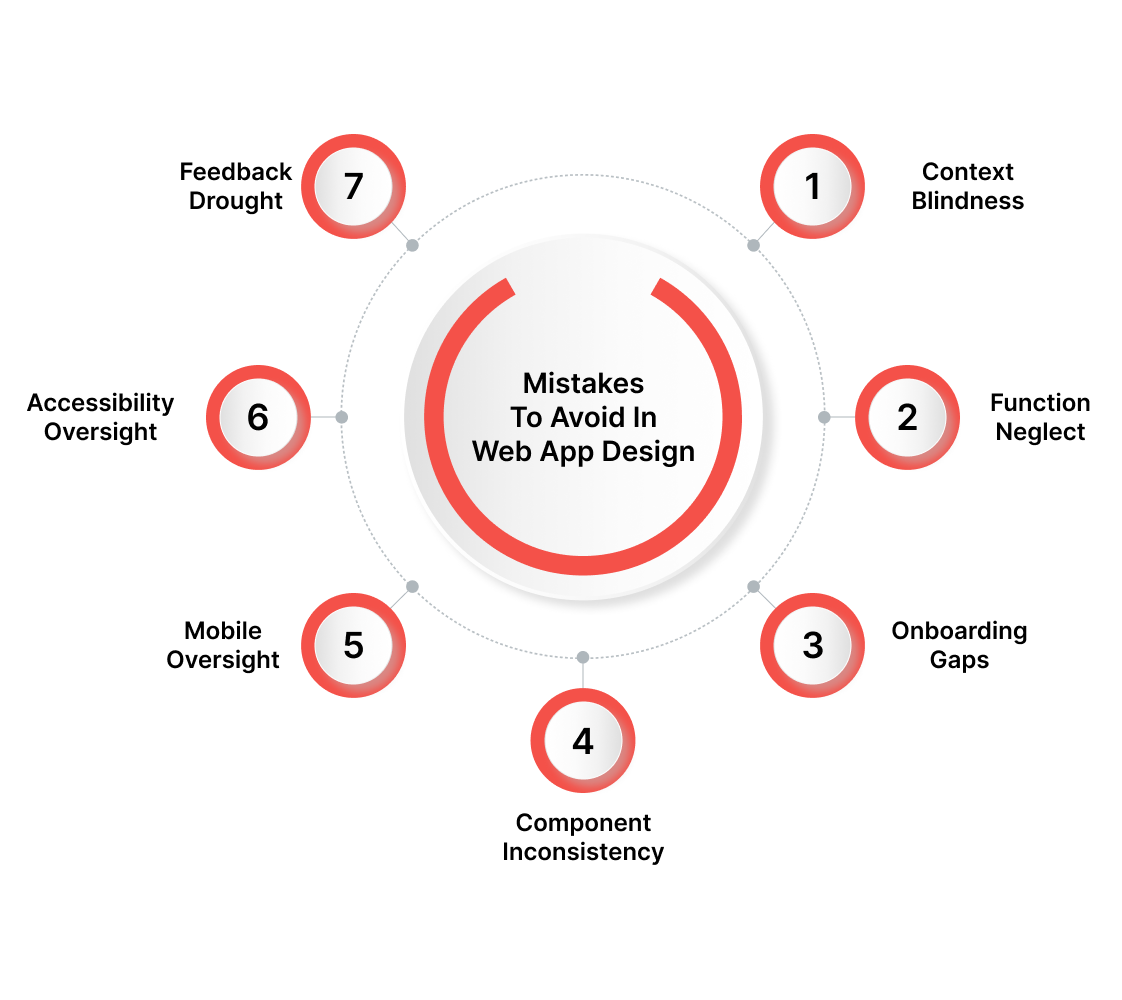
Even the most well-intentioned design decisions can backfire when they’re made without a clear understanding of user behavior. For B2B SaaS apps where users rely on your product to do meaningful, often high-stakes work, overlooking the following can lead to churn, bloated support tickets, and broken trust.
1. Designing Without Context
Many teams jump straight into layouts and screens without deeply understanding the workflows they’re designing for.
- Mistake: Building around features instead of user goals.
- Fix: Map real user journeys, shadow customer workflows, and validate flows with actual use cases before diving into visuals.
2. Prioritizing Aesthetics Over Function
A sleek UI means little if users can’t accomplish their core tasks quickly and easily.
- Mistake: Overloading the interface with too many options or hiding key actions behind clicks.
- Fix: Use progressive disclosure, remove low-usage elements, and prioritize primary tasks above the fold.
3. Ignoring Onboarding and First-Time Use
If users struggle during their first session, they rarely return.
- Mistake: Assuming users will “figure it out” without guidance.
- Fix: Build simple onboarding flows, use tooltips or empty state examples, and highlight key actions early.
4. Inconsistent Components and Behaviors
Inconsistency breeds hesitation. If the same element behaves differently across screens, trust erodes.
- Mistake: Creating screens in isolation or without a component library.
- Fix: Rely on a documented design system and test cross-screen interactions for consistency.
5. Neglecting Mobile Responsiveness
Even in B2B, mobile usage is rising, especially for dashboards, quick approvals, and alerts.
- Mistake: Designing only for desktop and assuming mobile is an edge case.
- Fix: Design mobile-first for key flows and test interactions on actual devices—not just resized screens.
6. Treating Accessibility as an Afterthought
Accessibility isn’t just a compliance issue, it’s a usability issue.
- Mistake: Skipping contrast checks, ignoring keyboard navigation, or omitting ARIA labels.
- Fix: Bake accessibility into your process from day one using WCAG 2.1 as your baseline.
7. Skipping Ongoing Feedback
Design is never “done.” Without user feedback, you’re guessing.
- Mistake: Launching and moving on without validating whether design decisions are working.
- Fix: Build in continuous discovery run usability tests, analyze behavior through tools like Hotjar, and stay close to customer support trends.
Most teams stop at fixing what’s broken. The best ones go a step further designing experiences that quietly do the heavy lifting. Interfaces that guide, adapt, and convert without getting in the way.
That’s the difference between a usable app and a product people actually want to stick with.
Build Experiences That Work, Not Just Interfaces That Look Good
A sleek UI isn’t enough. If your web app doesn’t help users work faster, make decisions quicker, or feel in control, they won’t stick around. For B2B SaaS, strong web app design is what turns a product into a platform and a trial user into a long-term customer.
And yet, many teams spend months perfecting their app while their website—the first thing prospects actually see gets left behind. If your site doesn’t immediately communicate value, reduce friction, and get people to sign up or book a demo, the product behind it may never get a shot.
That’s Where Beetle Beetle Comes In
We don’t build pretty websites.
We build high-converting ones that move your pipeline.
At Beetle Beetle, we specialize in end-to-end websites for B2B SaaS from positioning and messaging to custom design systems and scalable development. Whether you’re refining your product narrative or rebuilding your entire marketing site, we help you create an experience that reflects the strength of your software and converts at scale.
✅ Clear story.
✅ Built to scale.
✅ Designed to convert.
If your current website doesn’t match the maturity of your product, it’s time to upgrade.
Book a strategy call—and let’s turn your website into your strongest sales asset.
FAQs
1. How can I integrate analytics into my web app design?
Embed analytics directly into dashboards and sidebars, allowing users to view important data without disrupting their workflow. Utilize tools like Hotjar or Google Analytics to track user behavior and identify areas for improvement. This approach enables data-driven decisions and enhances user productivity.
2. What design trends should I consider for 2025?
In 2025, consider incorporating AI-assisted interfaces to simplify user interactions, adopting minimalist design principles to reduce cognitive load, and offering dark mode as a standard feature. Prioritize accessibility-first design and integrate embedded analytics to provide users with real-time data insights within their workflow.
3. How can I ensure my B2B SaaS web app is scalable?
To build a scalable web app:
- Use a modular design system with reusable components.
- Prioritize real user workflows to ensure easy navigation as the app grows.
- Plan flexible layouts that can adapt as the product evolves.
- Continuously test the app’s performance to identify and fix potential bottlenecks.
4. What tools should I use to design a B2B SaaS web app?
Some essential tools for web app design include:
- Figma: For collaborative design and real-time updates across teams.
- React.js: A popular frontend framework for creating reusable UI components.
- Node.js: For efficient backend development, especially for real-time data.
- Git: To manage version control and ensure smooth collaboration across teams.
These tools streamline development and make it easier to maintain consistency across the app.
5. How can I avoid decision fatigue in my web app design?
To reduce decision fatigue:
- Simplify navigation by minimizing menu options and using clear labels.
- Use a consistent design system across the app to help users become familiar with the interface quickly.
- Personalize user experiences and minimize unnecessary steps, making it easier for users to complete tasks with less effort.


.jpg)





























